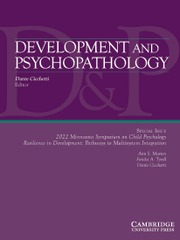Crossref Citations
This article has been cited by the following publications. This list is generated based on data provided by
Crossref.
Travis, John W.
2001.
Understanding Circumcision.
p.
367.
Macfie, Jenny
Cicchetti, Dante
and
Toth, Sheree L
2001.
Dissociation in maltreated versus nonmaltreated preschool-aged children.
Child Abuse & Neglect,
Vol. 25,
Issue. 9,
p.
1253.
Harter, Stephanie Lewis
2001.
Constructivist psychology of child abuse and implications for psychotherapy..
The Humanistic Psychologist,
Vol. 29,
Issue. 1-3,
p.
40.
Hildyard, Kathryn L
and
Wolfe, David A
2002.
Child neglect: developmental issues and outcomes☆.
Child Abuse & Neglect,
Vol. 26,
Issue. 6-7,
p.
679.
Nijenhuis, Ellert R. S.
Van der Hart, Onno
and
Kruger, Karlien
2002.
The psychometric characteristics of the traumatic experiences checklist (TEC): first findings among psychiatric outpatients.
Clinical Psychology & Psychotherapy,
Vol. 9,
Issue. 3,
p.
200.
2002.
A Developmental Model of Borderline Personality Disorder: Understanding Variations in Course and Outcome.
p.
1.
MURIS, PETER
MERCKELBACH, HARALD
and
PEETERS, ELKE
2003.
THE LINKS BETWEEN THE ADOLESCENT DISSOCIATIVE EXPERIENCES SCALE (A-DES), FANTASY PRONENESS, AND ANXIETY SYMPTOMS.
The Journal of Nervous and Mental Disease,
Vol. 191,
Issue. 1,
p.
18.
Kim, Jungmeen
and
Cicchetti, Dante
2003.
Social Self-Efficacy and Behavior Problems in Maltreated and Nonmaltreated Children.
Journal of Clinical Child & Adolescent Psychology,
Vol. 32,
Issue. 1,
p.
106.
Scott, Katreena L
Wolfe, David A
and
Wekerle, Christine
2003.
Maltreatment and trauma: tracking the connections in adolescence.
Child and Adolescent Psychiatric Clinics of North America,
Vol. 12,
Issue. 2,
p.
211.
Libby, Anne M.
Sills, Marion R.
Thurston, Norman K.
and
Orton, Heather D.
2003.
Costs of Childhood Physical Abuse: Comparing Inflicted and Unintentional Traumatic Brain Injuries.
Pediatrics,
Vol. 112,
Issue. 1,
p.
58.
Finzi, Ricky
Har-Even, Dov
and
Weizman, Abraham
2003.
Comparison of ego defenses among physically abused children, neglected, and non-maltreated children.
Comprehensive Psychiatry,
Vol. 44,
Issue. 5,
p.
388.
2004.
Guidelines for the Evaluation and Treatment of Dissociative Symptoms in Children and Adolescents: International Society for the Study of Dissociation.
Journal of Trauma & Dissociation,
Vol. 5,
Issue. 3,
p.
119.
Cardeña, Etzel
and
Weiner, Lupita A.
2004.
Evaluation of dissociation throughout the lifespan..
Psychotherapy: Theory, Research, Practice, Training,
Vol. 41,
Issue. 4,
p.
496.
Haugaard, Jeffrey J.
2004.
Recognizing and Treating Uncommon Behavioral and Emotional Disorders in Children and Adolescents Who Have Been Severely Maltreated: Dissociative Disorders.
Child Maltreatment,
Vol. 9,
Issue. 2,
p.
146.
Spinhoven, Philip
Roelofs, Karin
Moene, Franny
Kuyk, Jarl
Nijenhuis, Ellert
Hoogduin, Kees
and
Van Dyck, Richard
2004.
Trauma and Dissociation in Conversion Disorder and Chronic Pelvic Pain.
The International Journal of Psychiatry in Medicine,
Vol. 34,
Issue. 4,
p.
305.
Goldsmith, Rachel E.
Barlow, M. Rose
and
Freyd, Jennifer J.
2004.
Knowing and not knowing about trauma: Implications for therapy..
Psychotherapy: Theory, Research, Practice, Training,
Vol. 41,
Issue. 4,
p.
448.
Martínez-Taboas, Alfonso
Shrout, Patrick E.
Canino, Glorisa
Chavez, Ligia M.
Ramírez, Rafael
Bravo, Milagros
Bauermeister, José J.
and
Ribera, Julio C.
2004.
The Psychometric Properties of a Shortened Version of the Spanish Adolescent Dissociative Experiences Scale.
Journal of Trauma & Dissociation,
Vol. 5,
Issue. 4,
p.
33.
Kim, Jungmeen
and
Cicchetti, Dante
2004.
A Longitudinal Study of Child Maltreatment, Mother–Child Relationship Quality and Maladjustment: The Role of Self-Esteem and Social Competence.
Journal of Abnormal Child Psychology,
Vol. 32,
Issue. 4,
p.
341.
Carlson, Elizabeth A.
Alan sroufe, L.
and
Egeland, Byron
2004.
The Construction of Experience: A Longitudinal Study of Representation and Behavior.
Child Development,
Vol. 75,
Issue. 1,
p.
66.
Cicchetti, Dante
and
Toth, Sheree L.
2005.
Child Maltreatment.
Annual Review of Clinical Psychology,
Vol. 1,
Issue. 1,
p.
409.

